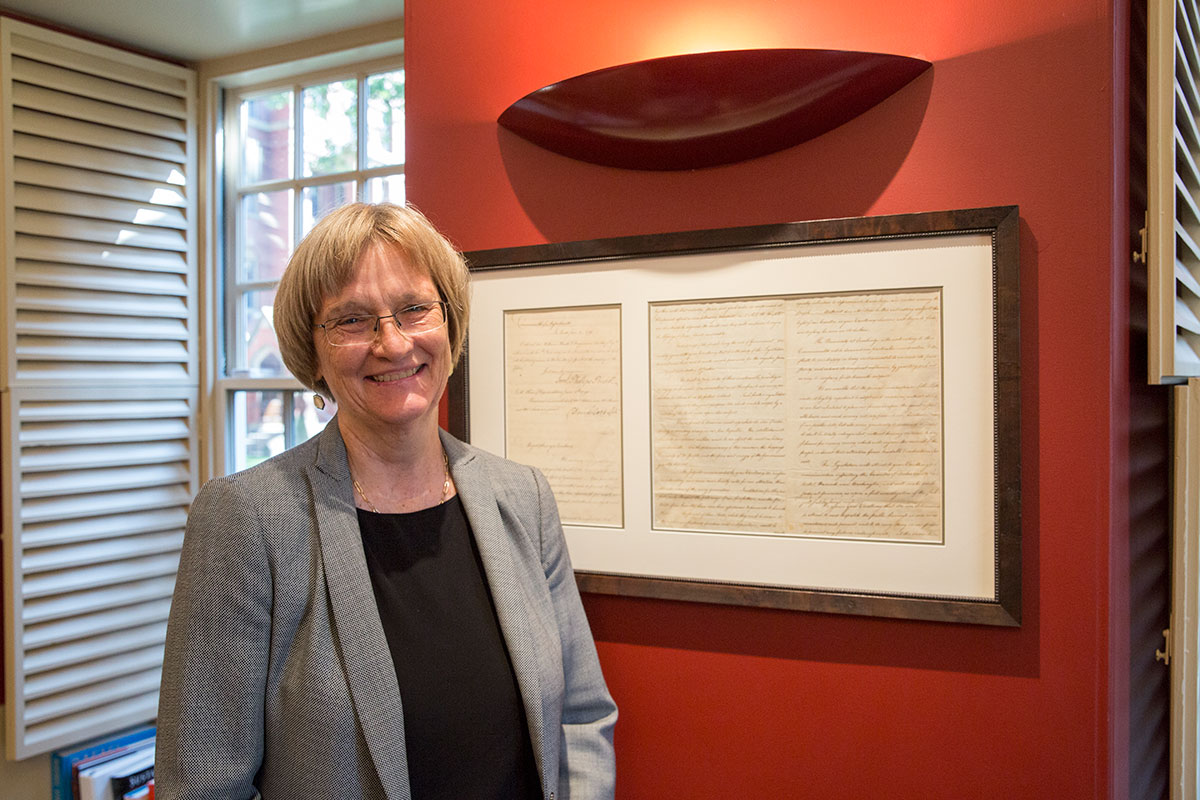
During her last year as Harvard president, Drew Faust plans to focus on making the case for the University’s needs and values in Washington, ensuring progress on inclusion and belonging for all, completing The Harvard Campaign, and nurturing development of the emerging Allston campus.
Jon Chase/Harvard Staff Photographer
For Faust, the road ahead
She’ll spend her last year as president advocating in Washington and focusing on campus inclusion and belonging, The Harvard Campaign, and the emerging Allston campus
Harvard President Drew Faust announced recently that she will step down next June, completing an 11-year tenure marked by increasing innovation, growth, reinvention, diversity, and inclusion. To start her last academic year as president, Faust sat for her annual Q&A session with the Harvard Gazette, discussing some of her top goals. These include completion of The Harvard Campaign, approval of the Enterprise Research Campus plans in Allston, and affirmation that Harvard is a citadel of inclusion and belonging. Faust also offered her thoughts on the Deferred Action for Childhood Arrivals program (DACA) and the clashes in Charlottesville, Va., provided a historian’s perspective on the removal of Civil War monuments, and discussed what her future may hold.
GAZETTE: This is the final year remaining in your presidency, the last for you to make change and advance your agenda. Are there one or two things that you’re really focused on getting done with your remaining time?
FAUST: Well, there are a couple of things that are underway that are really important to finish strong on. They include, of course, The Harvard Campaign, which will come to an end just as I will be stepping down. The campaign has been a huge success, and we’re so grateful to all the friends and alumni and others who have contributed to it. More than 140,000 households have been donors to the campaign. So the breadth of engagement as well as the enormous generosity have been terrific.
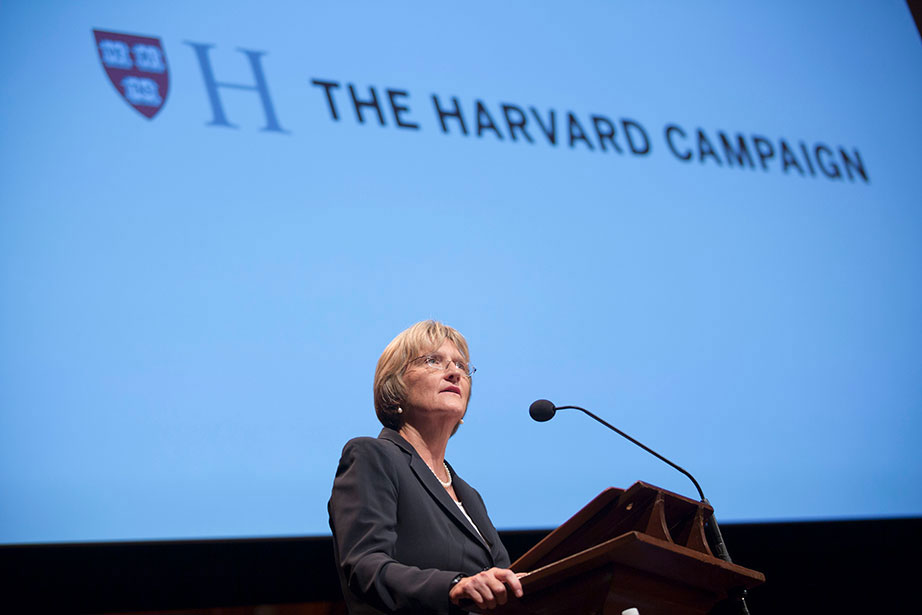
But there are certain aspects of the campaign that still need our attention. We’d like to finish strong on financial aid for all the Schools. We would like to raise some substantial money for scientific research and for the Science and Engineering Complex in Allston. House renewal is a big priority for the Faculty of Arts and Sciences (FAS), and we want to drive on that until the campaign’s conclusion. We also want to help the Schools as they strive to meet the targets that they set at the beginning of the campaign. That’ll be a big issue for me as I visit with donors and work with people here on campus — and I’ll also have a chance to say thank you to so many people who’ve been so supportive and have made this such a success.
A second thing is the Task Force on Inclusion and Belonging, which will finish its work and make some recommendations to me on ways we can help all members of our community thrive and feel that they truly belong. So I’ll be working with them as they craft their recommendations and as we figure out which things we can begin to work on right away and which things might be a little bit longer term. But that, of course, is part of a larger agenda on inclusion and belonging that we will be addressing in many ways across the campus in the course of the year.
As you may know, the Law School is celebrating its bicentennial this year with a series of special events. This week I attended a panel discussion about its early history along with the unveiling of a plaque honoring the enslaved people whose labor helped to make the School’s founding possible.
So dealing with Harvard’s history and its implications for the present and emphasizing the various parts of what we do in terms of inclusion and belonging will be priorities for me in the year ahead. Allston also is at a very exciting moment. We’ll be topping off the science and engineering building in the late fall.
We will also submit our plan for the Enterprise Research Campus in Allston to the city of Boston for approval. That’s another important step forward. Trader Joe’s is opening this fall, which is going to be exciting, I think, for the whole community. And of course, the Business School is moving along on Klarman Hall. There’s a lot of activity in the Allston space that we want to make sure to keep at high momentum in the year to come. Those are three areas that will be taking a lot of my attention.
GAZETTE: Can you tell me where the process currently stands on the issue of single-gender social organizations on Harvard’s campus? How do you feel about the process, and do you have a sense of timing on a final decision?
FAUST: A very important agenda item for me throughout my presidency has been expanding access through financial aid and expanding belonging of those we bring to this campus, and really emphasizing the importance of diversity to excellence. That means we want to attract people based on talent rather than other criteria, and we want to make sure that everybody feels fully welcome and can participate fully in campus life.
The single-gender social organizations are antithetical to much of that, in that they separate people out into small subgroups, and I think diminish the opportunity for students to take full advantage of what the diverse population of this campus can mean — and how it is such an important aspect of the educational experience. So we have been striving to address the issues of discrimination and separatism that characterize those organizations and, as you know, developed a policy about a year and a half ago that was meant to push those organizations more to the margins of undergraduate social life.
“A very important agenda item for me throughout my presidency has been expanding access through financial aid and expanding belonging of those we bring to this campus, and really emphasizing the importance of diversity to excellence.”
We found that the faculty turned out to be extremely interested in these questions and discussed them a great deal last year and wanted to have input and participation in addressing these issues. So last spring a group of faculty gathered as a committee to talk about how we might best achieve the goal of making sure that this is a campus in which each individual feels that she or he has full access to the opportunities that the University offers.
The faculty committee began to focus on the possibility of shutting down the organizations altogether. It issued a draft of the report in early summer with the expectation of discussing it further in a variety of venues, including, I think, the faculty council and some other faculty committees, while allowing individuals to express their opinions about their initial report. And they will, as I understand it, develop a final version of the report that will be discussed at the first FAS meeting of the year in early October.
Professor Harry Lewis and a number of other faculty have proposed a motion for that same meeting that says there can be really no control over student activities in relationship to independent social organizations. This troubles me a great deal because I think it’s a motion that would essentially say we will become a fraternity and sorority campus, something that is very at odds with the ideal of the House system and the kind of integrative function it has across the range of differences that our students bring to their experience here — geographic differences, socioeconomic circumstances, those of religion, race, ethnicity, political affiliation. It seems to me the great promise of being a College student at Harvard is learning from one another. That’s what the House system was designed to enable, and we want to reinforce that mission as we support the future of the experience for our students in the College.

GAZETTE: This notion of diversity and inclusion seems to be mirrored in the ongoing admissions lawsuit. Do you have an update on the status of the litigation against Harvard questioning its admissions policy with regard to race?
FAUST: This is a very important dimension or expression of our commitment to these goals, and so it is very closely related, as you suggest. We are defending against a case that challenges our admissions processes and the basis of looking at the whole person and taking a variety of admission factors into account, including race, but that’s only one of a number of factors as we select individuals to be members of a College class. We are in the midst of that case, and we’ve been in the process of completing depositions and discovery.
GAZETTE: Earlier you mentioned an ongoing priority in your final year will be completing The Harvard Campaign. While the campaign has broken records for fundraising in higher education, the University is also facing a time of constrained resources. Could you speak to how you see the budget and funding for programs and faculty and students in the coming years?
FAUST: There’s general agreement across higher education that endowment returns are likely to be more constrained in the decade to come than they were, for example, in the early 2000s before the financial crisis. So all of us are trying to understand what that means for the reliance on endowments that has dramatically increased in endowed institutions over the last couple of decades. We now get 36 percent of our annual operating budget from our endowment. Twenty years ago that figure was 23 percent. As we’ve grown more dependent on endowment returns and as we anticipate rather constrained endowment returns because of investment markets over the coming years, it challenges us to think how we manage that in terms of our ambitions, our budgets, while also trying to generate other sources of income.

We also are facing likely constraints on federal funding for science. The administration’s budget would cut the National Institutes of Health (NIH) funding by 24 percent. That would be a real body blow to higher education and research universities because we receive substantial amounts of funding from the federal government, and the NIH is the largest contributor to that. We received almost $600 million last year from the federal government for research funding.
So as we think about constraints on funding for research from the federal government, constraints on likely endowment returns and how that really limits what we would want to do about raising tuition — we certainly don’t want to put increased pressure on families — we have to be imaginative about what we do, how we do it, how we make choices, and also about other ways of generating resources.
We are focusing more on partnerships with industry as sources of support for research. We also see activities in many of the Schools that, in addition to supporting our core mission, could help contribute to their budgets. Continuing education does that, as do other kinds of activities that might enable us to achieve our goals in a way that would be affordable. So those are realities that I face and that a new president will certainly face as well.
GAZETTE: You mentioned federal funding for science. I know you increased your activity in Washington, D.C., over the past year. Can you elaborate a little bit on some of the issues you’ve been focusing on and what impact you think you’ve had?
FAUST: I have been spending a lot of time in Washington and devoting a lot of my attention to developing relationships there. I’ve been focused more or less on three areas. One is support for research and for student aid. A second is the possible taxing or other kind of regulation of endowments. And a third involves issues of immigration and the status of our undocumented students.
“What I think we’ve been able to do is to provide information and stories of discovery and stories of extraordinary young investigators and the trajectory of opportunity and discovery that officials can follow.”
In all those areas, I’ve worked closely with people on both sides of the political aisle, many of whom I’ve come to know over the decade of my presidency, and I’ve found real allies in the science area. There are many Republican representatives and senators who are strong allies on this. In fact, the final budget for FY ’17, which was passed in the spring — because it had been delayed — provided increases rather than decreases for NIH. I think there’s a lot of support in Congress for the mission of research and development and discovery in universities, so I’m encouraged by that.
What I think we’ve been able to do is to provide information and stories of discovery and stories of extraordinary young investigators and the trajectory of opportunity and discovery that officials can follow. And that has been very useful to members of Congress as they’ve made the case to their colleagues for support. So I’ve been really pleased about how receptive I’ve found people in Washington, and in fact found the vice president quite receptive to this role of universities in a meeting that I and several other university presidents had with him in July.
On the endowment question, we’ve been making the case that it is in fact endowments that enable us to support students, and that these are an essential tool and resource within our institutions that are valuable, and that taxing them will simply take away opportunities for students or take away opportunities for research, and so will be counterproductive.
I’ve gotten a fairly positive response from many individuals on both sides of the aisle again on that, so I feel that we’ve helped people to understand what can often seem incomprehensible. Endowments don’t make sense unless you live and breathe endowments. So we’ve been kind of teaching Endowment 101 around the country in one way or another to our alums and others and sending some of those messages out in conversations with people in Congress as well. And once again, I’ve gotten very positive responses for that, so we’ll see how it turns out when we get to tax revision time.
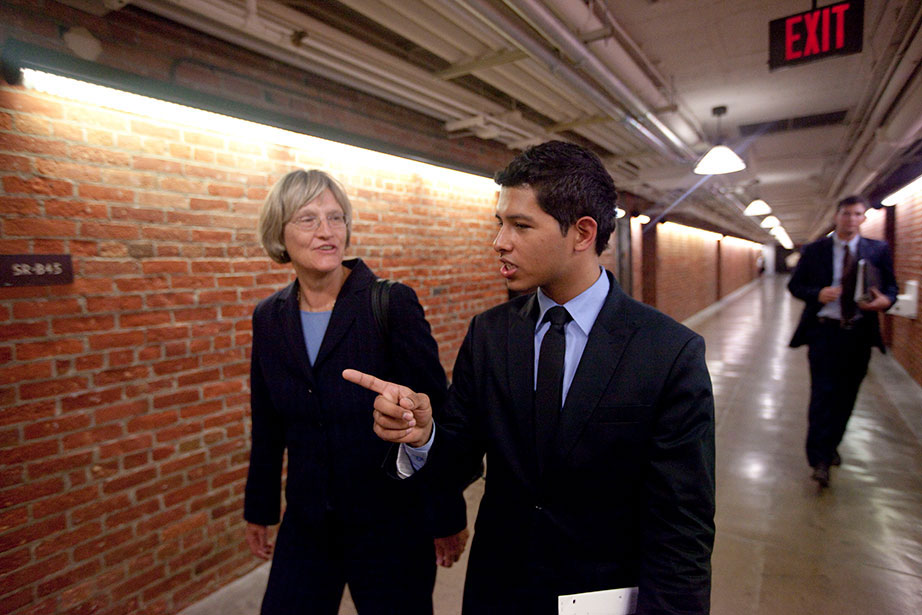
On the question of immigration and undocumented students, we will continue to make every effort to have our voice heard. I am deeply concerned about the administration’s decision to eliminate the Deferred Action for Childhood Arrivals program in six months, and I am committed to supporting those in our community who are affected. I recently sent a letter to President Trump urging him to preserve the DACA protections, and one to the leaders of both the Senate and House of Representatives urging that Congress resolve this issue legislatively, whether through the DREAM Act or the BRIDGE Act. Such protections are critical for our undocumented students, whose accomplishments, dedication, and creativity contribute to our community and our country in innumerable ways.
Fortunately, we have some strong allies in Congress. Sen. Dick Durbin has been a staunch supporter for many years, and I worked with him earlier on the DREAM Act, which he co-sponsored. He’s also been very helpful to some of our undocumented students at various points along the way. He and Sen. Lindsey Graham have a bipartisan bill that they are putting before Congress now to, they hope, establish support for the DREAMers in legislative form.
So I will keep working on this important issue. It’s been a signature one for me in a way since early in my presidency, and we’ll continue to support these students and also to make our case for immigration issues more broadly, because we need people around the world to have access to us and for us to be able to recruit talent from around the world. So there are a number of immigration issues that are of central concern to our strength as an institution.
GAZETTE: It sounds like you’ve gotten strong bipartisan support in D.C. Does that surprise you?
FAUST: I don’t think so. I don’t see why a university should be seen as a partisan cause. I think that we are one of America’s great accomplishments. We’re a jewel. American higher education is the best in the world. I would hope that would be evident to people on both sides of the aisle.
“I don’t see why a university should be seen as a partisan cause. I think that we are one of America’s great accomplishments. We’re a jewel. American higher education is the best in the world. I would hope that would be evident to people on both sides of the aisle.”
And I think also that, over the years, the Harvard name and the Harvard experience have given me access to a lot of individuals who are Harvard alums who may be Republicans or may be Democrats, but are honored and happy to see their president — meaning Harvard’s — come to visit. In the Senate, there are six Republicans and seven Democrats who are Harvard alumni. I think that might surprise people.
Over the years, I’ve met with Sen. Ted Cruz. I’ve met with Sen. Ben Sasse. I’ve met with Sen. Dan Sullivan from Alaska. I’ve met with Sen. Pat Toomey. These are all Harvard alums. Sen. Tom Cotton. And even people who aren’t Harvard alums have been quite open — Sen. Roy Blunt, for example. Congressman Tom Cole has been absolutely fabulous on all the science issues. Plus, I think some of them enjoy talking about the Civil War, so that’s another matter of common interest.
GAZETTE: Turning to history, as a Civil War historian [Harvard’s Lincoln Professor of History], how do you view what’s been happening with Civil War monuments in cities and campuses across the nation, as well as the recent events in Charlottesville? How do you think that trend reflects on Harvard and its efforts to come to terms with its own connections to slavery?
FAUST: First, let me say about Charlottesville, it’s just horrifying and heartbreaking. As I mentioned in my recent Morning Prayers address, when I was growing up in Virginia it was a segregated society that closed many of its public schools rather than integrate them after Brown v. Board. And as I watched Virginia change, it was just so heartening to see Virginia elect Douglas Wilder, an African-American, as governor. I’ll never forget the night of the 2008 election, when Virginia went for Barack Obama. I just thought, “This is a different world,” and a far better one than the discriminatory environment in which I grew up. So to see the kind of hatred and bigotry that was put on display in Charlottesville was heart-rending.
“I think turning to history has to be done with great humility, not so much to judge and condemn the past as to understand it as a template for the present.”
You were asking about the emphasis on history, which obviously was a central component of the Charlottesville issue, because it centered on a statue of Robert E. Lee. I think it’s appropriate and good for the United States to look at its history, because I do think that there are many legacies of that history in our own time, and we need to understand those. If we try to simply live in the present, there’s a lot about social arrangements in this country that we won’t understand. So to look back and see what the experience of different groups in this country have been and the ways in which law and custom reinforced and set the parameters for hatred and discrimination is an important lesson, not least because it makes us look to ourselves and say, “What don’t I see about my own time?” It’s not so much to condemn people in the past that we look at the past, but to understand how they came to see that daily reality as the appropriate choice for them and for their society. It makes us understand better, I think, the choices we have in our own time and the choices that we have made in our own time — and the choices we might be making now that our grandchildren will deplore. So I think turning to history has to be done with great humility, not so much to judge and condemn the past as to understand it as a template for the present.
When I think about changing names or removing statues and so forth, I think that we have to examine carefully each instance of what we want to consider and ask, “Why was this monument put here? Why was this name put here? Was it meant to be a defiant act? Was it meant to be simply an act of honoring? Did this person on balance contribute positively to the world, even though he or she may have had some retrograde” — it’s almost never she — “have some retrograde notions in their own time? Or was this person completely dedicated to a set of ideas that we would not want to honor?”
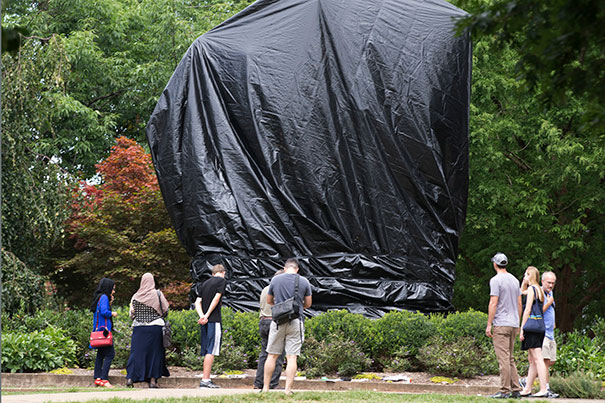
There’s been a good bit of discussion of this, I think, in a very effective way in recent weeks, where the notion of Confederate monuments has been particularly scrutinized. Robert E. Lee fought against the United States to create a nation whose cornerstone, its vice president then said, was the institution of slavery. Do we want to honor this person?
One of the most interesting aspects of these Lee memorials is when were they put there and for what purpose. As some have pointed out in recent weeks, there was a resurgence of these as Jim Crow was being solidified in the 1890s and early 1900s, and again another resurgence of them in resistance to Brown v. Board and the Civil Rights Movement. A statue that is put up as a defiant monument to white supremacy under attack is a monument that is compromised, in my view, in a way that we should recognize and respond to.
I’ve spoken sometimes about visiting West Point. West Point’s been asking itself these questions because Lee was superintendent there. I would say that a little plaque that says Robert E. Lee was superintendent of West Point from 1852–1855 is a very different kind of memorial than something that was erected in the aftermath of Brown v. Board to say white supremacy forever.
There’s been the question about George Washington and Robert E. Lee. I think there’s a big set of differences there, and that looking at these instances — and asking, “Is this a monument to defiant white supremacy, or is it a monument to a human being who made important contributions to the world we live in today?” — we need to be quite nuanced in how we ask these questions.
GAZETTE: We’ve discussed your goals for the University during your final year, but, on a more personal level, are there things that you’re going to try to take time to appreciate about Harvard before you step down as president, experiences or places or anything in particular that you will try to really savor during your final year in office?
FAUST: Yes. There’s so much about this community that’s just a joy. A lot of it is watching the talented people in this environment do their thing. Whether that’s a faculty discussion or seminar or talk, whether it’s an athletic event where I can see the students striving for their excellence, whether it’s in the arts, which of course is a favorite dimension of Harvard for me, I want to take time to really enjoy those things. That’ll be a big part of it.
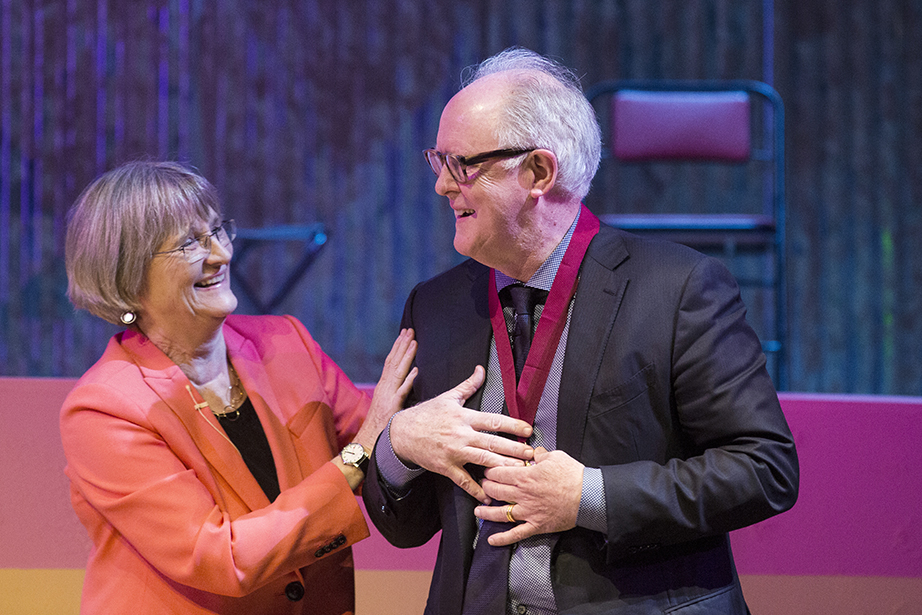
GAZETTE: Turning to potential post-presidency projects, I wonder if you have any thoughts on the next book you’d like to write? A couple of years ago, you mentioned that you’d really enjoyed writing a biography early on in your career. Do you have plans to do that again, and any possible subjects in mind?
FAUST: I have a sabbatical year, and I see the work of that year being really to define what the next project is. So we’ll see. I spent a lot of time this summer when I was on vacation working on an essay about a photographer named Sally Mann. I was asked to write a chapter for a catalog for an exhibition of her work that will open at the National Gallery in March and then come up to the Peabody Essex Museum. One of the sets of photographs in this exhibition is of seven landscapes of Civil War battlefields, so they asked if I would write something about her.
She’s about four years younger than I am, but she grew up in the Shenandoah Valley not that far from where I grew up. So there were all these similarities from childhood and interest in the South. That was a great experience for me to have the opportunity to do that, and it just reminded me of how much I enjoy thinking and writing. So we’ll see where it goes.
GAZETTE: Do you think you’ll come back to Harvard and teach?
FAUST: Well, one of the things I feel I have to do in my sabbatical is figure out whether I know how to be a historian anymore, so we’ll see. I’ll give it a little practice and see how it goes.
GAZETTE: In 2012, you delivered an address at Boston College’s sesquicentennial titled “Scholarship and the Role of the University,” in which you quoted Harvard President Nathan Pusey, who said we rely on universities not merely to create economic value but “to build value into our common life.” In the wake of recent divisions across the country, I wonder if you think that line is even more relevant today?
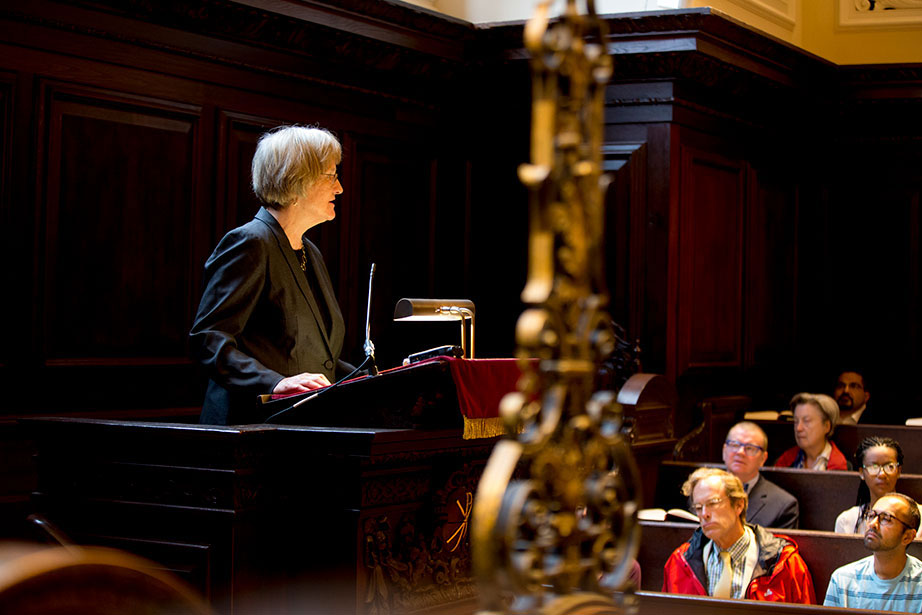
FAUST: It’s a great quote. In my remarks at Morning Prayers, I mentioned that I enjoyed being invited to speak on the first day of school every year because it enabled me to step back and not just be caught up in the flurry of the new year, and not just to ask what is it we’re doing and how are we doing it, but why are we doing it? In my address, I noted how Harvard is devoted to the pursuit of truth and knowledge, to the understanding that learning enhances human capacity toward tolerance, diversity, and inclusion, and to the obligations each of us bears toward one another and toward something greater than ourselves. This is what we believe. These are our values. This is what inspires us and motivates us.
“It’s also an important role for a university to serve in a larger society, to step back and say: ‘Where are we? What are we about? How does all this fit together? What are the questions we need to ask ourselves to make sure that we keep our eyes on the North Star and that we make sure that our actions are directed toward something bigger than simply ourselves?’”
I think that’s very important. I think it’s important for a president to do that for a university, to be the spokesperson for those bigger questions. But I think it’s also an important role for a university to serve in a larger society, to step back and say: “Where are we? What are we about? How does all this fit together? What are the questions we need to ask ourselves to make sure that we keep our eyes on the North Star and that we make sure that our actions are directed toward something bigger than simply ourselves?”
GAZETTE: Closing with a much less complicated topic, last summer you adopted a shelter puppy named Alice. Can you give us an update on how she is doing?
FAUST: Alice is fine.
GAZETTE: Where you ever able to identify her breeds?
FAUST: Well, we did a DNA test, but I don’t know whether to trust it or not, because there are some odd parts of it. One said she was a small part Great Pyrenees, but she’s just not big enough to have had very much Great Pyrenees in her, so that made me wonder. But the percentage that she had most of was Labrador. Now, she’s almost all white. She’s got a black dot on her head and a little black thing on her tail. So that was also quite surprising to me, until I learned this summer how much she loves to swim. She’s just a fish. So maybe that’s her Labrador thing. She has a lot of Australian cattle dog in her and a lot of Australian shepherd. That all made sense.
GAZETTE: So does she herd?
FAUST: Yes, she does.
This interview has been lightly edited for length and clarity.




